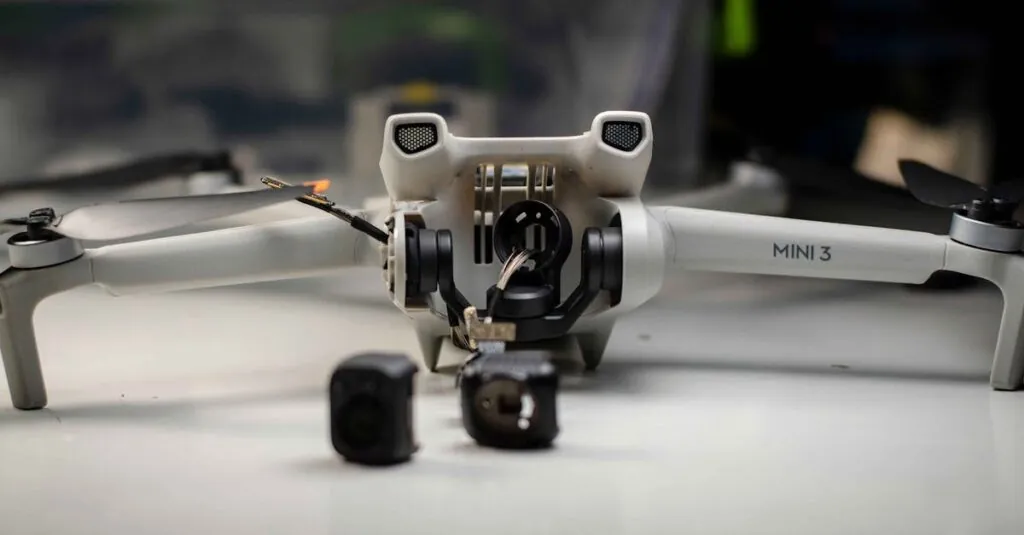In a world where your coffee maker can argue with you and your fridge knows more about your diet than you do, next-gen gadgets are here to revolutionize everyday life. Imagine a smart assistant that not only plays your favorite tunes but also gently reminds you to stop binge-watching and start adulting. These futuristic devices blend convenience with a sprinkle of fun, making daily tasks feel less like chores and more like a scene from a sci-fi movie.
Table of Contents
ToggleOverview of Next-Gen Gadgets
Next-generation gadgets significantly enhance daily life. Smart home devices integrate seamlessly into routines, providing convenience and efficiency. For example, a voice-activated coffee maker brews your favorite blend while engaging in conversation. Additionally, refrigerators equipped with technology monitor dietary habits, suggesting meal plans based on preferences and health goals.
These devices often connect to a central smart assistant, allowing users to control multiple gadgets with ease. Smart assistants manage tasks from playing music to scheduling chores, facilitating a balanced lifestyle. Kitchen gadgets, such as smart ovens, adapt cooking times and temperatures based on the recipe selected, reducing the guesswork involved in meal preparation.
Wearable technology also plays a crucial role in health monitoring. Smartwatches track fitness metrics, heart rate, and sleep patterns, prompting users to stay active and maintain wellness. Coupled with mobile apps, these wearables offer insights that encourage healthier habits.
Robotics continue to make strides in home automation. Robotic vacuums autonomously clean spaces while navigating obstacles. These devices save time and effort, allowing individuals to focus on other important tasks.
Augmented reality (AR) gadgets redefine gaming and training experiences. Users immerse themselves in interactive environments, promoting engagement and learning. In retail, AR applications enhance shopping experiences by allowing visualizations of products in real-time.
Next-gen gadgets represent an exciting intersection of technology and daily activities. As innovations roll out, they promise to further simplify tasks, creating smart environments tailored to individual needs. These advancements transform mundane routines into enjoyable daily experiences.
Key Innovations in Next-Gen Gadgets
Next-gen gadgets showcase remarkable advancements that enhance user experience and improve daily life efficiency. These innovations focus on making technology more intuitive and responsive to individual needs.
Artificial Intelligence Integration
Artificial intelligence drives the functionality of many next-gen gadgets. Smart home systems analyze behavior patterns to optimize energy usage and enhance security. Devices equipped with AI, like virtual assistants, interact seamlessly, learning preferences to provide personalized suggestions. For instance, smart thermostats adjust temperatures based on user habits. These devices not only simplify home management but also save time and effort through automation. Increased capabilities enable gadgets to engage conversationally, making interactions feel more natural and intuitive.
Enhanced Connectivity Features
Enhanced connectivity transforms how devices communicate within smart ecosystems. Technologies like 5G facilitate quicker connections and lower latency, allowing gadgets to work harmoniously together. Many next-gen gadgets support various protocols, ensuring compatibility across devices, regardless of the manufacturer. Smart refrigerators now sync with smartphones, providing grocery alerts and meal suggestions based on available ingredients. These features streamline tasks, ensuring users remain informed and efficient in managing their households. Enhanced connectivity extends to wearables, with seamless syncing to health apps for real-time data tracking, further promoting an integrated lifestyle.
Popular Next-Gen Gadgets in the Market
Next-generation gadgets revolutionize everyday tasks, making life more convenient. Many of these devices enhance user experience through smart integration.
Smart Home Devices
Smart home devices offer remarkable convenience and efficiency. For instance, smart thermostats adjust temperatures automatically based on user habits, optimizing energy consumption. Voice-activated assistants control lighting and appliances hands-free, simplifying daily routines. Smart security systems provide real-time alerts, ensuring peace of mind. Moreover, robotic vacuum cleaners autonomously maintain cleanliness, allowing users to focus on other activities. These advancements highlight how smart home technology transforms living spaces into automated environments that cater to individual needs.
Wearable Technology
Wearable technology encompasses devices that monitor health and fitness continuously. Smartwatches track heart rates and activity levels, encouraging users to stay active and healthy. Fitness bands quantify sleep patterns, providing insights for better rest. Other wearables, such as smart glasses, enhance experiences by overlaying digital information on the physical world. Communication between wearables and smartphones promotes seamless interactions, helping users manage schedules and notifications effectively. Innovations in this sector continue to reshape how people engage with their health and surroundings.
Future Trends in Next-Gen Gadgets
Innovations in next-gen gadgets emphasize smart interactions and user customization. Artificial intelligence increasingly personalizes experiences, empowering devices to adapt to individual preferences. Smart home systems analyze behavioral patterns to enhance energy efficiency and security.
Robotics also advance, shifting household tasks from manual to automated. Robotic vacuums, for instance, operate efficiently within smart homes, allowing users to focus on other activities. Wearable technology reflects this trend, as devices track health metrics in real-time, promoting wellness and fitness.
Augmented reality continues to redefine user experiences in gaming and shopping. Glasses with AR capabilities enable immersive gaming; shoppers visualize products in real-world settings before purchase decisions. Such technologies integrate seamlessly into everyday routines, enhancing convenience.
5G technology stands at the forefront of improved connectivity. Enhanced speed and lower latency facilitate devices’ communication within smart ecosystems. Smart refrigerators, for example, sync with smartphones to alert users about grocery needs and suggest meals based on stock.
Analytics drive new functionalities in familiar gadgets. Next-gen ovens autonomously adjust cooking times based on recipe selections, ensuring optimal results. Voice-activated assistants provide reminders and manage schedules, streamlining daily responsibilities.
Market trends highlight consumer demand for seamless integration of gadgets into everyday life. Smart thermostats and security systems enhance comfort and safety significantly. As innovations unfold, these devices aim to simplify routines while delivering enjoyable experiences, making technology a staple in modern lifestyles.
Conclusion
Next-gen gadgets are reshaping how individuals interact with technology in their daily lives. With advancements in artificial intelligence and connectivity, these devices are not just tools but companions that enhance convenience and efficiency. As they become more integrated into everyday routines, users can expect a seamless experience that caters to their unique needs.
The future of technology promises even more innovation, with smart devices evolving to offer personalized solutions and smarter interactions. Embracing these gadgets is not just about adopting new tools; it’s about stepping into a lifestyle where technology simplifies tasks and enriches experiences. As these trends continue to unfold, the potential for smarter living is limitless.









